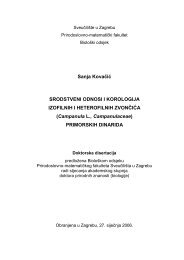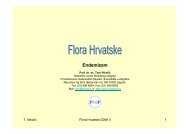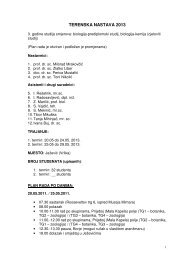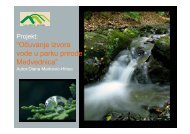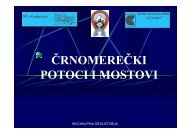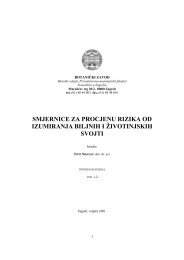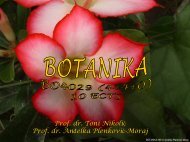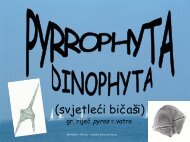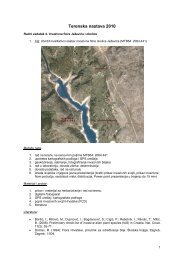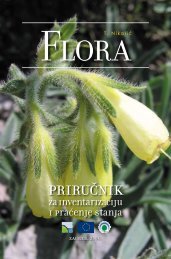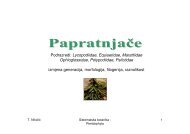important plant areas in central and eastern europe - hirc.botanic.hr ...
important plant areas in central and eastern europe - hirc.botanic.hr ...
important plant areas in central and eastern europe - hirc.botanic.hr ...
Create successful ePaper yourself
Turn your PDF publications into a flip-book with our unique Google optimized e-Paper software.
Section 5ReferencesFor IPA presentations at the PlantaEuropa IV Conference, 2004, please go to(www.nerium.net/<strong>plant</strong>aeuropa/Submissions.htm or www.nerium.net/<strong>plant</strong>aeuropa/OralPresentations.htm)Anna Asatryan: Important Plant Areas <strong>in</strong>Armenia: research for conservation.Vileta Atienza: Lichen data as a contributionto the identification of IPAs <strong>in</strong> the ValencianCommunity.Teresa Gil Gil: Important Plant Areas <strong>in</strong>Navarra Region.Eszther Illyes: An <strong>in</strong>troduction to thePannonian habitats <strong>and</strong> flora <strong>and</strong> the IPAprogramme <strong>in</strong> Hungary.Pérez-Rovira P. et al: The micro-reservesnetwork as a prelim<strong>in</strong>ary approach to IPAselection <strong>in</strong> the Valencian Community.Radford, E.: IPAs go global.Del Valle E. et al: Important <strong>areas</strong> for theSpanish endangered flora.For <strong>in</strong>formation on the South AfricanNational Biodiversity Institute – formerhosts of SABONET (www.nbi.ac.za)For <strong>in</strong>formation on the ASEAN RegionalNetwork for Biodiversity Conservation(www.arcbc.org)For <strong>in</strong>formation on the New Zeal<strong>and</strong>Plant Conservation Network(www.nzpcn.org.nz)For general <strong>in</strong>formation on IPA projects <strong>in</strong>different countries (www.<strong>plant</strong>life.org.uk)Evans, S., Marren, P. & Harper, M., 2002,Important Fungus Areas: a provisionalassessment of the best sites for fungi <strong>in</strong> theUnited K<strong>in</strong>gdom. Plantlife,Association ofBritish Fungus Groups, British MycologicalSociety.Özhatay, N., Byfield,A.,Atay, S., 2003,Türkiye’n<strong>in</strong> Önemli Bitki Alanlari (IPAs <strong>in</strong>Turkey).WWF Türkiye (Dogul HayatiKoruma Vakfi), IstanbulIPA projects <strong>in</strong> Europe <strong>and</strong> otherparts of the worldCentral <strong>and</strong> <strong>eastern</strong> EuropeAs well as the projects detailed above there are develop<strong>in</strong>g IPA projects or <strong>in</strong>terest <strong>in</strong>start<strong>in</strong>g IPA projects <strong>in</strong> several other countries. In Hungary, a project to identify IPAs isbe<strong>in</strong>g developed by researchers at Eötvös Loránd University <strong>and</strong> the RegionalEnvironmental Centre (REC). In Armenia, a project to collate <strong>and</strong> analyse exist<strong>in</strong>g datahas been carried out at the Institute of Botany. Researchers <strong>in</strong> Ukra<strong>in</strong>e at the Institute ofBotany, Kyiv, have made an assessment of <strong>plant</strong> conservation <strong>in</strong> protected <strong>areas</strong>.Individuals <strong>and</strong> organisations <strong>in</strong> Georgia, Lithuania, Latvia <strong>and</strong> Moldova have expressedtheir <strong>in</strong>terest <strong>in</strong> develop<strong>in</strong>g IPA projects.Other parts of EuropeTurkey was the first country anywhere <strong>in</strong> the world to complete its IPA identification.The project was carried out by the NGO Dogal Hayati Koruma Demegi (DHKD), theInstitute of Botany, the University of Istanbul, <strong>and</strong> Flora <strong>and</strong> Fauna International <strong>and</strong> theresults published by WWF Turkey. Researchers at the F<strong>in</strong>nish Environment Institute havebegun work on projects to identify <strong>important</strong> fungi <strong>and</strong> <strong>plant</strong> <strong>areas</strong> <strong>in</strong> F<strong>in</strong>l<strong>and</strong>. In the UKthe national IPA team, coord<strong>in</strong>ated by Plantlife International, <strong>in</strong>cludes specialists from awide range of organisations <strong>in</strong>clud<strong>in</strong>g the state agencies <strong>and</strong> the specialist societies.Projects to identify Important Fungus Areas <strong>and</strong> Important Stonewort Areas <strong>in</strong> the UKhave already been completed. In Spa<strong>in</strong> several research projects <strong>in</strong>to IPAs <strong>in</strong> differentregions have begun, <strong>in</strong>clud<strong>in</strong>g the Valencia <strong>and</strong> Navarra regions.In June 2003, the IUCN Centre of Mediterranean Cooperation, Planta Europa <strong>and</strong>Plantlife International coord<strong>in</strong>ated an IPA workshop with participants from Croatia,Cyprus, Egypt, France, Greece, Gibraltar, Italy, Lebanon, Morocco <strong>and</strong> Spa<strong>in</strong>. S<strong>in</strong>ce then, anational IPA workshop has been held <strong>in</strong> Morocco, where 53 prelim<strong>in</strong>ary IPAs wereidentified, <strong>and</strong> a proposal for a national IPA project has been developed <strong>in</strong> Lebanon.Other parts of the worldIn May 2004, SABONET, the Southern Africa Botanical Network, organised a regionalIPA workshop for seven countries (Angola, Malawi, Mozambique, Namibia, South Africa,Zambia <strong>and</strong> Zimbabwe). Subsequently, national IPA workshops were carried out <strong>in</strong>Mozambique <strong>and</strong> Namibia. Us<strong>in</strong>g exist<strong>in</strong>g data, 28 prelim<strong>in</strong>ary IPAs have been identified<strong>in</strong> Mozambique <strong>and</strong> 39 <strong>in</strong> Namibia. In South Africa, IPA team members are <strong>in</strong> the processof analys<strong>in</strong>g considerable amounts of exist<strong>in</strong>g <strong>plant</strong> data <strong>in</strong> order to select IPAs.The ASEAN network <strong>in</strong> south east Asia has also begun the process of discuss<strong>in</strong>g IPAprojects at a regional level with representatives from n<strong>in</strong>e countries (Brunei, Cambodia,Indonesia, Lao, Malaysia, the Philipp<strong>in</strong>es, S<strong>in</strong>gapore,Thail<strong>and</strong>,Vietnam).The New Zeal<strong>and</strong> Plant Conservation Network is develop<strong>in</strong>g a strategy forimplement<strong>in</strong>g IPAs <strong>and</strong> the other targets of the Global Strategy for Plant Conservation.Stewart, N. F. 2004, Important StonewortAreas, An assessment of the best <strong>areas</strong> forstoneworts <strong>in</strong> the United K<strong>in</strong>gdom. PlantlifeInternational, Salisbury, U.K.78



